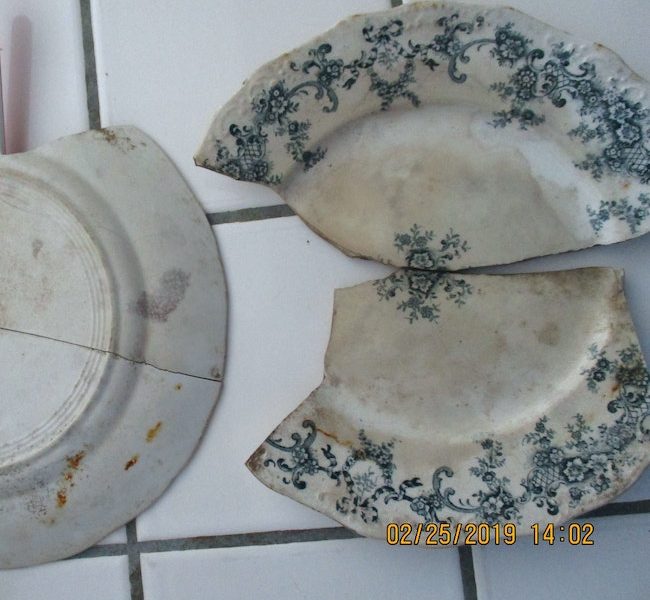 Front and back view of the plate.
Front and back view of the plate.
Over the winter of 2019, you saw a flurry of activity at the Old School House/Library. Creswell Heritage Foundation had acquired money through grants and generous private donations to replace the foundation and front porch.
During excavation, a treasure trove of historical cultural items was found under the building. The contractor, who specializes in historic preservation, saved it all for us. Among the items were two broken plates that were likely used by the Creswell Civic Improvement Club, the CCIC, when it owned the building.
These plates are earthenware pottery – which is common, thicker than china, and easily chips, though these fragments are not chipped and the decorative pattern is clear. The marking on the back of the plate tells the story of when and where the plate was made. They were two of a set made by WTH Smith & Co., at Cable Pottery in Longport, England near Burslem, Stoke-on-Trent, the largest pottery-producing city. The serial numbers indicate they were made in 1899.
The bluish-black pattern is Dewey Cable with its delicate bows and flower garlands, and embossed decorative raised curlicues and dots at the scalloped edges.
The mystery is how these lovely pottery shards ended up under the soon-to-be rehabilitated building. This building was designed for social gatherings: a Schoolhouse, a Baptist Church, and the CCIC, for which the building is on the National Register of Historic Places. The Creswell School owned the building from 1875-96, before the plates were fired in kilns.
The Baptist Church owned the building from 1900-26, a possible time period when a congregation member would have donated the plates.
The Creswell Civic Improvement Club owned the building the longest, 1927-79. The Creswell Heritage Foundation has documentation that many businesses and families from Eugene, Cottage Grove, Creswell and even Oregon City helped build and furnish the clubhouse for the CCIC.
 Detail of the back of the plate.
Detail of the back of the plate.
It is believed that the kitchen was added to the building at that time. There is a record that several businesses and families donated dishes. These broken plates likely came from one of these sources.
The plate shards would have been dumped under the building along with other non-compostable household items. This is common before modern sanitation, which was not typical in most small cities and towns until the 1940s.
Creswell’s Deberry Landfill was used from 1950-74. Cultural Archeologists go to burn piles, old wells and cisterns, under houses, or holes dug specifically to bury household refuge to find out about the people who lived in the area. They find tools, dishes, utensils, children’s toys and anything else the people would need for their daily life.
As Creswell Heritage Foundation continues with the rehabilitation of the Old Schoolhouse, we will be diligent to save any cultural remnants such as the medicinal bottle, reported in an earlier Chronicle edition, and these plate shards found during construction. They will be kept or displayed to celebrate Creswell’s past citizens who lived to make our present.
 Detail of the back of the plate.
Detail of the back of the plate.
May is National Historic Preservation Month. Cheri Spaulding is a member of the Creswell Heritage Foundation and wrote this for The Chronicle.








